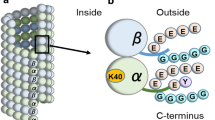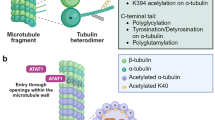Summary
Links unusual for their length and variable morphology have been described between manchette microtubules in late stages of rat spermiogenesis. In earlier stages of rat spermiogenesis obvious links longer than ∼160 Å are rare, the majority being ∼80 or ∼120 Å in length. The most easily discernible geometric pattern in cross-sections of assemblies of manchette microtubules in intermediate stages of rat spermiogenesis is that of linear arrays sometimes resulting in long and irregularly folded chains of closely linked microtubules. Colcemid disrupts these arrays and is responsible for the formation of more complex geometric patterns. Six hours after drug administration the manchette is dramatically reduced in length. Sheet-like links of variable dimensions and >160 Å in length interconnect not only microtubules but C-type microtubules as well as other links. These links are similar in morphology to those found in later stages of rat spermiogenesis. It is suggested that the formation of these links may perhaps be dependent upon aspects of microtubule disassembly.
Similar content being viewed by others
References
Behnke, O., Forer, A.: Evidence for four classes of microtubules in individual cells. J. Cel Sci. 2, 169–192 (1967).
Behnke, O., Forer, A.: Vinblastine as a cause of direct transformation of some microtubules into helical structures. Exp. Cell Res. 73, 506–508 (1972).
Bencosme, S. A., Stone, R. S., Latta, H., Madden, S. C.: A rapid method for localization of tissue or lesions for electron microscopy. J. biophys. biochem. Cytol. 5, 508–510 (1959).
Clermont, Y., Perry, B.: The stages of the cycle of the seminiferous epithelium of the rat: Practical definitions in PA-Schiff hematoxylin and hematoxylin-eosin stained sections. Rev. canad. Biol. 16, 451–462 (1957).
Cohen, W. D., Gottlieb, T.: C-microtubules in isolated mitotic spindles. J. Cell Sci. 9, 603–619 (1971).
Franke, W. W.: Cytoplasmic microtubules linked to endoplasmic reticulum with cross bridges. Exp. Cell Res. 66, 486–498 (1971).
Luft, J. H.: Improvements in epoxy resin embedding methods. J. biophys. biochem. Cytol. 9, 409–414 (1961).
MacKinnon, E. A., Abraham, P. J.: The manchette in stage 14 rat spermatids: A possible structural relationship with the redundant nuclear envelope. Z. Zellforsch. 124, 1–11 (1972).
Roth, L. E., Pihlaja, D. J., Shigenaka, Y.: Microtubules in the helizoan axopodium. I. The gradion hypothesis of allosterism in structural proteins. J. Ultrastruct. Res. 30, 7–37 (1970).
Roth, L. E., Shigenaka, Y.: Microtubules in the helizoan axopodium. II. Rapid degeneration by cupric and nickelous ions. J. Ultrastruct. Res. 31, 356–374 (1970).
Sabatini, D. D., Bensch, K., Barrnett, R. J.: Cytochemistry and electron microscopy. The preservation of cellular ultrastructure and enzyme activity by aldehyde fixation. J. Cell Biol. 17, 19–58 (1963).
Stevens, R. E.: Reassociation of microtubule protein. J. molec. Biol. 33, 517–520 (1968).
Tilney, L. G.: Studies on the microtubules in Helizoa. IV. The effect of colchicine on the formation and maintenance of the Axopodia and the redevelopment of pattern in Actinosphaerium nucleofilum (Barrett). J. Cell Sci. 3, 549–562 (1968).
Tilney, L. G.: How microtubule patterns are generated: The relative importance of nucleation and bridging of microtubules in the formation of the axoneme of Raphidiophrys. J. Cell Biol. 51, 837–854 (1971a).
Tilney, L. G.: Origin and continuity of microtubules. Results and problems in cell differentiation. II. In: The origin and continuity of cell organelles, p. 222–260. Berlin: Reinert and Zurich: Ursprung 1971b.
Tucker, J. B.: Fine structure and function of the cytopharyngeal basket in the ciliate Nassula. J. Cell Sci. 3, 493–514 (1968).
Tucker, J. B.: Initiation and differentiation of microtubule patterns in the ciliate Nassula. J. Cell Sci. 7, 793–821 (1970).
Turner, R. F.: Modified microtubules in the testis of the water strider, Gerris regimis (Say). J. Cell Biol. 53, 263–270 (1972).
Venable, J. H., Coggeshall, R.: A simplified lead citrate stain for use in electron microscopy. J. Cell Biol. 25, 407 (1967).
Author information
Authors and Affiliations
Additional information
Supported by a grant to E. A. MacKinnon by the Medical Research Council of Canada.
Rights and permissions
About this article
Cite this article
MacKinnon, E.A., Abraham, P.J. & Svatek, A. Long link induction between the microtubules of the manchette in intermediate stages of spermiogenesis. Z.Zellforsch 136, 447–460 (1973). https://doi.org/10.1007/BF00307363
Received:
Issue Date:
DOI: https://doi.org/10.1007/BF00307363




